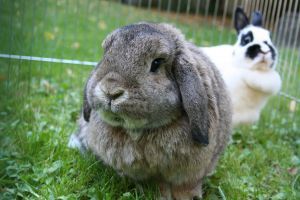You see rabbits at every pet shop. They’re impossibly adorable with their playfulness. There’s always at least one that catches your eye. With one twitch of his nose and touch of his velvety soft fur, you feel compelled to take him home and take care of him.
Sure, they’re cute and easy to fall in love with, but most people don’t realize the amount of effort and money it takes to own a rabbit. The fact that they primarily reside in cages can mislead people into thinking that they are less work than a cat or dog, but actually rabbits can turn out to be a lot more work than previously bargained for. Especially when the rabbit lives indoors, which for a variety of reasons, exposure and danger from other animals being two main ones, are why rabbits should not be housed outside. Before you think about getting one of these furry creatures, here’s what you should know:
- Housing. Buying a cage is the best place to keep a rabbit when he isn’t running around. Make sure the cage is spacious enough for the rabbit to move around, stand up and stretch. Also, don’t buy a cage with a wire bottom. That can hurt the bunny’s feet.Be sure to place the cage in a room where the rabbit will have plenty of contact with you and your family. Rabbits are social creatures-they like to be around people and in the middle of the action.
- Food/water containers. After buying a cage, you’ll need to buy a food bowl (one that won’t easily tip over as rabbits are notorious for playing with them) and a water bottle. Bottles work best because they only need to be changed every few days (versus every day with a water bowl) and are much more sanitary.
- Litter training. Rabbits can easily be taught to be litter trained. It’s so easy that all you need to do is buy a litter pan specially made for small animals (available at most pet stores) and put it in the rabbit’s cage. Your rabbit will take over from there. Pans should be changed about once a week.Also, be sure to avoid using cedar chips or wood shavings to line the litter pan. If your bunny chews on the shavings, it can seriously damage his digestive tract. Instead, use recycled newspaper pellets or wood pellets. They have better absorbency, not to mention healthier for your rabbit.
- Neutering/spaying. After buying a rabbit, it’s extremely important to get he or she fixed. This not only stops the risk of breeding (if you have one of each sex), it helps calm hormones (which can cause your rabbit to spray you with urine when he gets upset) and starve off the risk of health problems later on in the rabbit’s life.
- Bunny-proofing. Since rabbits have a destructive nature, it will be necessary to “bunny-proof” your home.Electrical wires and computer and phone cords will need to be pulled together through a plastic wire protector or placed away from the rabbit’s view as rabbits love to chew on them.Many other domestic items can prove deadly to rabbits, so keep potpourri, cigarette butts, pesticides, plant food, prescription drugs and antifreeze away from an inquisitive rabbit.
- Exercise. Just like dogs, rabbits need exercise.Depending on your breed of rabbit, it can be absolutely necessary to let your pet out its cage to run around. Even though you may have “bunny-proofed” your house, it’s probably not enough to safeguard against the type of damage a rabbit can commit. That’s why it’s a good idea to buy a pen for your rabbit to run around in. Throw some toys in and your rabbit will be content.
- Toys. You may be tempted to go out and buy “designated” animal toys, but your rabbit will most likely be uninterested. Instead, rabbits find entertainment in items you probably already have in your home. Objects like empty paper towel and toilet paper rolls and cardboard boxes are favorites among rabbits.Keep an eye on how much the rabbit is enjoying his toy. If he’s been eating it, switch to another type of material like fabric or plastic to see which type of toy promotes chewing rather than eating.
- Diet. A rabbit’s diet is essential to his happiness and health. They should have a varied diet of pellets, vegetables and hay mixed in with some fruits and treats. Hay provides a good amount of fiber to a rabbit’s diet. So well, in fact, they can have an unlimited amount. Be sure to have hay on hand at all times.Carrots, kale, alfalfa and endive are also proved good nutrition as well as blueberries, pears and strawberries. If you want to reward your rabbit for good behavior, you can treat them to 1 tbsp. of dry oatmeal, unfrosted, dry cereal like Cheerios or ¼ slice of bread (whole wheat is best). Though it isn’t the healthiest of treats and should be distributed sparingly, rabbits go nuts for Cheez-Its.
- Social animals. Rabbits are very social, not just with each other, but with humans, too. They enjoy attention and love to play. However, by nature a rabbit can be extremely cautious and jumpy around new people, including you. Be patient, your rabbit will come around. It helps if you don’t “force” yourself onto the rabbit. Let the rabbit come to you. Once he realizes he is in a safe, loving environment, he will become more playful and affectionate.
- Twice as nice. If you find that you enjoy taking care of your rabbit and playing with him, you may be thinking about getting another one. Not only does this mean doubling your food supply and buying another cage and other supplies, it means additional planning on your part. Introducing another rabbit into your home can upset the one you already have. Introductions between the old rabbit and new should be done carefully as the two rabbits may start fighting. In fact, you should never leave two new rabbits alone with each other until you are sure they get along. Until the two accept each other, you should keep them in their respective cages and limit their contact with one another.







